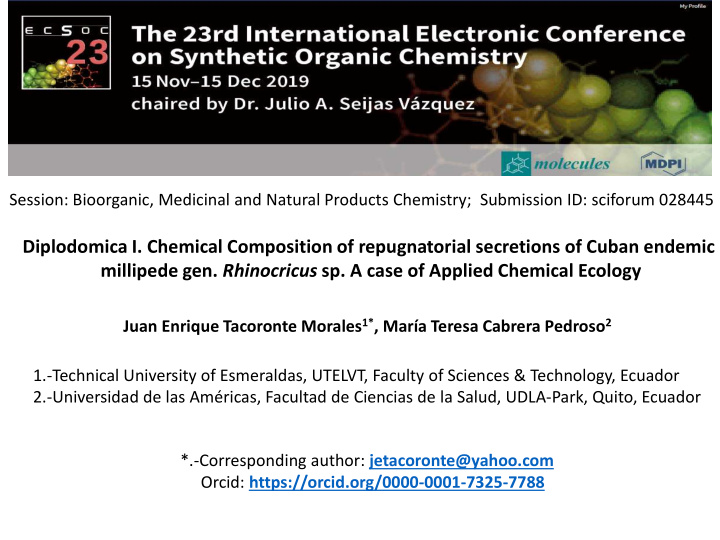



Session: Bioorganic, Medicinal and Natural Products Chemistry; Submission ID: sciforum 028445 Diplodomica I. Chemical Composition of repugnatorial secretions of Cuban endemic millipede gen. Rhinocricus sp. A case of Applied Chemical Ecology Juan Enrique Tacoronte Morales 1* , María Teresa Cabrera Pedroso 2 1.-Technical University of Esmeraldas, UTELVT, Faculty of Sciences & Technology, Ecuador 2.-Universidad de las Américas, Facultad de Ciencias de la Salud, UDLA-Park, Quito, Ecuador *.-Corresponding author: jetacoronte@yahoo.com Orcid: https://orcid.org/0000-0001-7325-7788
Graphical Abstract
Abstract: Analysis of the chemical composition of the ejaculated repugnatorial secretion of some populations of the Cuban endemic millipede Rhinocricus inhabiting in the western eco- geographical region of the Cuban archipelago has been developed. During research has been identified several quinonoids metabolites (quinones and phenols natural products) as an active components. Many species of millipedes (Diplopoda) respond to disturbance by coiling up into a tight spiral keeping the head in the centre and ejecting, if further disturbed as defensive strategy, a noxious, topically irritant, with variable composition, fluid, being highly toxic an even cytotoxic. In the defensive secretions of millipedes have been identified hydrocyanic acid, esters, acids, aldehydes, terpenoids, cyanogenic compounds, phenols, 1,4-benzoquinones, quinazolines, alkaloids, aromatic nitriles, and amino-nitro compounds. The most frequently detected are substituted quinonoids (phenols and 1,4-benzoquinones). Some individuals (males) gathered from raked forest soil at the edge of the tropical forest, in some cases in typical carst region, were collected. 850 μg of a deep brown-red secretion obtained by means of glass capillary from the individual studied, were directly introduced into analytical instrumental (GC-MS and FTIR). The analysis of FTIR spectrum and GC-MS spectrum show that the main components of secretions are substituted hydroquinones, substituted 1,4 benzoquinones and aldehydes. The biological effects of these defensive secretions were evaluated on pathogenic microorganisms. The results showed a very interesting antimicrobial action. The ecological and evolutionary significance of chemical differentiation in millipedes populations are under study. Keywords: chemical composition, defensive secretion, millipede, chemical ecology
Introduction Advances in the chemistry of natural products, chemical ecology, via metabolomics and chemogenomics, offer new opportunities for bioprospecting of biodiversity in searching for new molecular entities with potential bioactivity and industrial applications, starting from minimum quantities of biological material. The biodiversity of the (edaphic) fauna of terrestrial invertebrates of the Cuban archipelago has not been satisfactorily chemo-prospected; the efforts, presented here, are oriented to the isolation and strategic development of leading molecular systems based on secondary metabolites that would constitute a new potential pharmacological, agrochemical and structural entities ( NEF + NEA + NEE). There are no reports detailing chemical ecology and structural aspects of defensive secretions of Millipedes inhabiting in different eco-geographical regions of Cuban tropical archipelago (1,2). 1.- Tacoronte J., et al . Una benzoquinona natural aislada de secreciones defensivas de un milípedo cubano endémico (2005). Revista CNIC. Ciencias Químicas Vol. 36, n.2, pag.115-116 2.- Tacoronte J., Cabrera Pedroso, M.T. (2018) Secreciones defensivas de invertebrados terrestres. Ecología química aplicada. Perspectiva molecular y ecosustentable de la biodiversidad ecuatoriana. Capítulo de libro Un Espacio para la Ciencia Vol 1, N.1. Cap.2 Pag. 51-100. ISSN 2631-2689
Protocol for chemical BIOMASS bio-prospecting Release of collected (male millipede) individuals to nature stimulation isolation, Absorb defensive secretion on filter paper characterization and and capillaries structural elucidation Green Synthesis of Major bioactive To cold a - 10 0 C Bio- components screening Et 2 O To dry con N 2 (g) - + Molecular Information store at -10C GC-MS Analysis Chemical tests (drops) + Other targets DCM Intelligent-signals (FT- IR, NMR, GC-MS, TLC) Other tests Structural Filtre (0,45 µm) Atta, Aedes characterization - + Inyection 1-2 µL ( Bio-tests, ATLC, FT-IR, (GC-MS) GC-MS, NMR) Purification Isolation thru TLC, TLC, HPLC HPLC (semi-prep )
Compositional differences of defensive secrectons depending of collection sites. in situ studies B -Banao; A -Alamar; Mog .-Mogotes; Y .-Yumurí; Is .-Isla de la Juventud; P .-La Palma; My .-Mayari; Esc .-Escalera de Jaruco (geographical points of populations under study) Thin Layer Chromatography on SiO 2 plates doped with silver nitrate
Results
Results Staphylococcus aureus cas 62 Staphylococcus aureus case 45 Staphylococcus aureus case 26 Toxicological evaluation of defensive repugnatorial secretions from Millipedes Microorganism Toxicological doses MIC Fonsecae pedrosi MIC = 6,0 µg /mL Candida albicans MIC = 30,0 µg /mL Microsporum gypeseum MIC = 78,0 µg /mL Microsporus canis MIC = 56,3 µg /mL Trycophyton mentagraphytes MIC = 27,0 µg /mL Epidermophyton flocossum MIC = 68,0 µg /mL Trycophyton rubrum MIC = 44,0 µg /mL
It was evidenced the existence of eco-geographical variations and potential chemotypes in 6 (I-V) populations of millipede gen. Rhinocricus sp. that inhabit in Cuban tropical archipelago (West ecozones) The five chemotypes determined were: Yumurí Valley-02- Isla de la Juventud (two components, 31/33 and 61.8 / 66% respectively); Alamar-Banao locations (5-9 components with remarkable differences in secondary metabolite concen- trations); La Palma (1 component, 100%, phenolic nature); Coca (mixture of aliphatic hydrocarbons with traces of substituted phenols); and Yumurí Valley-01 (quinona >90%). Two new molecular entities for defensive secretion of endemic Spirobolida gen. Rhinocricus sp. in Cuban tropical archipelago (Banao and Alamar collection area) were determined: 2-(3,4-dimethoxy-phenyl)-ethylene-1-amine and 4-hydroxy-5-methoxy- benzaldehyde (vanillin). The molecular mapping of compositions of the defensive secre- tions isolated from Rhinocricus sp. populations revealed the existence of a singular com- positional heterogeneity (5-7 components of aromatic, benzoquinone and hydrocarbon nature with specific substitution patterns) in the western area of the Cuban archipelago. Repugnatorial secre-tions showed interesting microbiocidal activity (fungicide) vs. patho- genic micro-organisms. Studies on the evolutionary chemical significance of these poly- component mixtures are currently under development. Acknowledgments This study was supported, in part, by the institutional and financial support from Prometheus Project Ecuador “Chemical Bioprospecting of Tropical Biodiversity” 2016-2017.
Recommend
More recommend